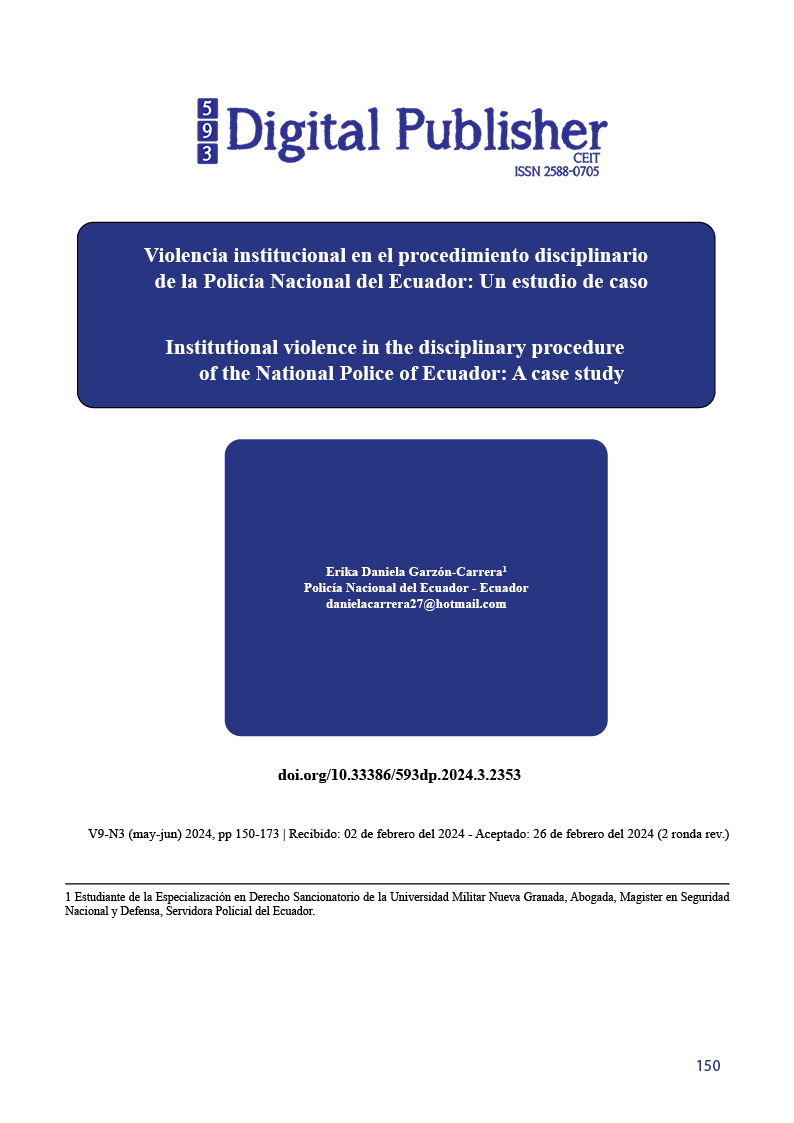Institutional violence in the disciplinary procedure of the National Police of Ecuador: a case study
Main Article Content
Abstract
This academic essay reviews theoretically and legally the definition of gender violence, as well as the types that occur depending on its manifestations. Based on this, it identifies as cases of gender violence, certain disciplinary offenses contained in the Organic Code of Citizen Security and Public Order Entities, a legal norm that supports the disciplinary regime of the National Police of Ecuador. By doing so, it recognizes the existence of a victim in the administrative disciplinary procedure that is carried out in said institution, due to the commission of any of these disciplinary offenses by one of its members; victim who is not legally admitted at present, which is why, in a normalized manner, institutional violence occurs that is seen through revictimization and impunity when these cases occur; aspects that are demonstrated in this document, statistically and through the analysis of a case study. Finally, several factors are examined that must be considered by those involved in the administrative disciplinary procedure of the National Police of Ecuador to avoid the exercise of this form of violence, ensuring at all times the rights of the victim and thus harmonizing the relationship that is forged between it and the agents of the State.
Downloads
Article Details

This work is licensed under a Creative Commons Attribution-NonCommercial-ShareAlike 4.0 International License.
1. Derechos de autor
Las obras que se publican en 593 Digital Publisher CEIT están sujetas a los siguientes términos:
1.1. 593 Digital Publisher CEIT, conserva los derechos patrimoniales (copyright) de las obras publicadas, favorece y permite la reutilización de las mismas bajo la licencia Licencia Creative Commons 4.0 de Reconocimiento-NoComercial-CompartirIgual 4.0, por lo cual se pueden copiar, usar, difundir, transmitir y exponer públicamente, siempre que:
1.1.a. Se cite la autoría y fuente original de su publicación (revista, editorial, URL).
1.1.b. No se usen para fines comerciales u onerosos.
1.1.c. Se mencione la existencia y especificaciones de esta licencia de uso.
References
Boledón, E. (2014). Violencia institucional y violencia de género. Anales de la Cátedra Francisco Suárez, 131-155.
Carrasco, J. (2011). La nulidad procesal como técnica protectora de los derechos y garantías de las partes en el derecho procesal chileno. Revista de Derecho Universidad Católica del Norte, 49-84.
Carrión, M. (2006). El género de la violencia de género. Ciudad segura. Programa de Estudios de la Ciudad, 1.
Caso Veliz Franco y otros vs. Guatemala (Corte Interamericana de Derechos Humanos 19 de mayo de 2014).
Código Orgánico de las Entidades de Seguridad Ciudadana y Orden Público (2017).
Código Orgánico General de Procesos (2018).
Constitución de la República del Ecuador (2008).
Corte Constitucional de Colombia. (2004). Sentencia 014/04. Obtenido de https://www.corteconstitucional.gov.co/relatoria/2004/C-014-04.htm#:~:text=Por%20regla%20general%20no%20existen,internacional%20de%20los%20derechos%20humanos.
Guemureman, S., Otamendi, A., Zajac, J., Sander J. y Bianchi, E. (2017). Violencias y Violencias Estatales: hacia un ejercicio de conceptualización . Revista Ensambles primavera, 12-25.
Guerrero, P. (2008). Los derechos de las víctimas en el proceso disciplinario. Ley 734 de 2002. Bucaramanga.
Gutiérrez, C., Coronel, E., y Pérez C. (2009). Revisión teórica del concepto de victimización secundaria. Liberabit, 49-58.
Gutiérrez, F. y Escobar, C. (2010). La teoría del delito y la teoría de la falta disciplinaria en el derecho positivo colombiano (análisis comparativo). Derecho y Realidad, 217-235.
Ley Orgánica Integral para Prevenir y Erradicar la Violencia contra las Mujeres (2018).
Marquéz, Á. (2011). La victimología como estudio. Redescubrimiento de la víctima para el proceso penal. Revista Prolegómenos - Derechos y Valores, 36.
Méndez, M. (2022). Prácticas judiciales, impunidad y femicidio en Ecuador. Facultad Latinoamericana de Ciencias Sociales, 1-59.
Orentlicher, D. (2005). Cuadro sinóptico del conjunto de principios actualizado para la protección y la promoción de los derechos humanos mediante la lucha contra la impunidad. Consejo Económico y Social de la Naciones Unidas.
Organización de la Naciones Unidas. (17 de Junio de 2023). Naciones Unidas. Obtenido de Centro Regional de Información: https://unric.org/es/la-violencia-de-genero-segun-la-onu/
Piqué, M. (2017). Revictimización, acceso a la justicia y violencia institucional. Julieta Di Corleto (coordinadora), Género y derecho penal. Buenos Aires: Didot., 1-37.
Reglamento Sustitutivo al Reglamento para la Aplicación del Régimen Disciplinario del Libro I del Código Orgánico de las Entidades de Seguridad Ciudadana y Orden Público (2021).
Salas, P. (15 de 10 de 2022). La caducidad y su aplicación en el procedimiento administrativo disciplinario policial. Lima, Perú.
Sosa, M. (2021). Investigar y juzgar con perspectiva de género. Revista Jurídica AMFJN, 1-10.
Sttico, G. y Villanueva,C. (2022). LA VIOLENCIA LABORAL EN ECUADOR EN EL MARCO DEL CONVENIO 190 DE LA OIT. Entre la incertidumbre política y la baja sensibilización social. Fesminismos, 1-46.


